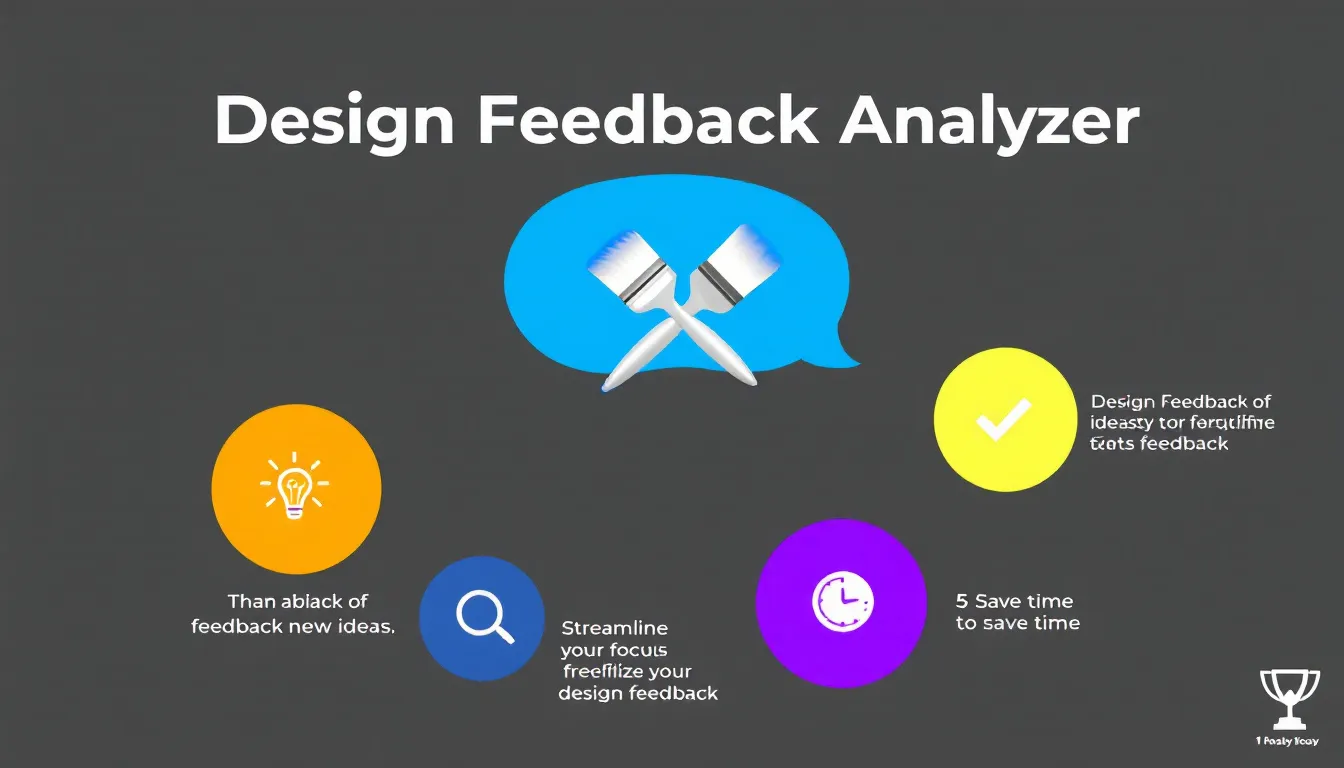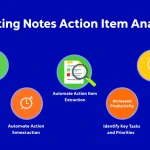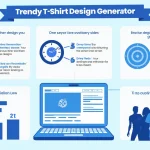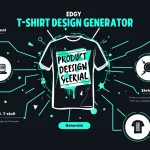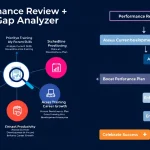Design Feedback Form
Is this tool helpful?
How to Use the Design Feedback Tool Effectively
To make the most of our Design Feedback Tool, follow these simple steps:
- Client Feedback: Enter the detailed feedback received from the client regarding the current design. For example, “The website layout feels cluttered, and the color scheme doesn’t align with our brand identity. We’d like a more minimalist approach with emphasis on our product images.”
- Design Type: Specify the type of design you’re working on. This could be “e-commerce website redesign” or “corporate brochure update.”
- Current Design Elements: (Optional) Describe the key elements of the current design. For instance, “Current palette: navy blue and gold; Font: Helvetica; Layout: grid-based with heavy use of stock photos.”
- Client Preferences: (Optional) Note any specific preferences or requirements mentioned by the client. An example could be “Incorporate more white space, use custom illustrations instead of stock photos, and ensure mobile responsiveness.”
- Generate Suggestions: Click the “Generate Design Revision Suggestions” button to receive tailored advice based on your input.
After submitting, you’ll receive a comprehensive set of design revision suggestions tailored to address the client’s feedback and preferences.
Empowering Designers: An Introduction to the Design Feedback Tool
In the fast-paced world of graphic design, effectively addressing client feedback is crucial for project success and client satisfaction. Our Design Feedback Tool is a cutting-edge solution that bridges the gap between client expectations and designer creativity, streamlining the revision process and enhancing communication.
This innovative tool leverages advanced algorithms and design principles to analyze client feedback, design type, and preferences, generating tailored suggestions for design revisions. By providing structured, actionable insights, it empowers designers to efficiently adapt their work while maintaining their creative vision.
Purpose and Benefits
The primary purpose of the Design Feedback Tool is to facilitate smoother, more effective design iterations. It aims to:
- Streamline the feedback implementation process
- Enhance designer-client communication
- Reduce revision cycles and project timelines
- Ensure client satisfaction while preserving design integrity
By utilizing this tool, designers can transform potentially vague or subjective feedback into concrete, actionable steps, leading to more efficient project workflows and improved client relationships.
Unleashing Creativity: The Benefits of Using the Design Feedback Tool
1. Time Efficiency
One of the most significant advantages of the Design Feedback Tool is its ability to save time. By quickly processing client feedback and generating specific revision suggestions, designers can:
- Reduce time spent interpreting ambiguous feedback
- Minimize back-and-forth communication for clarification
- Accelerate the revision process
This time-saving aspect allows designers to focus more on creative tasks and take on additional projects, potentially increasing their productivity and profitability.
2. Enhanced Communication
Effective communication is the cornerstone of successful design projects. The Design Feedback Tool acts as a translator between client feedback and designer action, offering several communication benefits:
- Clarifies client expectations by breaking down feedback into specific elements
- Provides a structured format for addressing each aspect of the feedback
- Helps designers explain their revision choices to clients more effectively
- Reduces misunderstandings and miscommunications
3. Consistency in Design Revisions
Maintaining consistency across multiple revisions can be challenging, especially for complex projects or when working with multiple team members. The Design Feedback Tool helps ensure consistency by:
- Providing a standardized approach to interpreting and addressing feedback
- Offering suggestions that align with established design principles and best practices
- Creating a clear record of feedback and corresponding revision suggestions
4. Creative Problem-Solving Support
While the tool doesn’t replace a designer’s creativity, it serves as a valuable brainstorming partner. It can:
- Suggest alternative approaches to addressing client concerns
- Inspire new ideas by presenting different perspectives
- Help designers overcome creative blocks when faced with challenging feedback
5. Client Satisfaction and Relationship Building
By facilitating more effective revisions, the Design Feedback Tool contributes to improved client satisfaction. This, in turn, can lead to:
- Stronger designer-client relationships
- Increased likelihood of repeat business
- Positive word-of-mouth referrals
- Enhanced professional reputation
Addressing User Needs: How the Design Feedback Tool Solves Specific Problems
Problem 1: Interpreting Vague Feedback
One of the most common challenges designers face is deciphering vague or non-specific feedback from clients. The Design Feedback Tool addresses this by:
- Analyzing the provided feedback for key themes and concerns
- Generating specific, actionable suggestions based on design principles
- Providing a framework for designers to ask follow-up questions if needed
Example: If a client provides feedback like “The design doesn’t feel right,” the tool might suggest exploring color psychology, reassessing the visual hierarchy, or refining the typography to better align with the brand’s personality.
Problem 2: Balancing Client Requests with Design Integrity
Designers often struggle to incorporate client requests while maintaining the overall design quality and coherence. The Design Feedback Tool helps by:
- Offering suggestions that align with both client preferences and design best practices
- Providing alternative solutions that meet client needs without compromising design integrity
- Highlighting potential areas of compromise or education for the client
Example: If a client requests to “make the logo bigger” on a well-balanced layout, the tool might suggest alternative ways to emphasize the brand, such as using the logo colors in key design elements or incorporating brand imagery in strategic locations.
Problem 3: Managing Multiple Revision Requests
Large projects often involve multiple stakeholders with diverse feedback. The Design Feedback Tool assists in managing this complexity by:
- Categorizing and prioritizing different feedback elements
- Identifying common themes across multiple pieces of feedback
- Suggesting comprehensive solutions that address multiple concerns simultaneously
Example: In a website redesign project where one stakeholder focuses on visual appeal and another on user experience, the tool might suggest a redesign approach that enhances visual elements while improving navigation and information architecture.
Problem 4: Adapting Designs Across Different Mediums
With the increasing need for designs to work across various platforms and mediums, designers often face challenges in adaptation. The Design Feedback Tool helps by:
- Providing medium-specific suggestions based on the design type input
- Offering insights on how to maintain design consistency across different formats
- Suggesting responsive design techniques for digital projects
Example: For a branding project that needs to work in both print and digital formats, the tool might suggest a flexible color palette with both CMYK and RGB values, and recommend scalable logo designs that work well in various sizes and resolutions.
Practical Applications: Real-World Examples of the Design Feedback Tool in Action
Case Study 1: Corporate Website Redesign
Client Feedback: “Our current website looks outdated and doesn’t reflect our innovative approach. We want a more modern, user-friendly design that showcases our tech expertise.”
Tool Suggestions:
- Implement a clean, minimalist design with ample white space to convey modernity
- Use a bold, sans-serif typography for headings to emphasize innovation
- Incorporate interactive elements like hover effects and subtle animations to demonstrate tech-savviness
- Redesign the navigation for improved user experience, possibly using a sticky header
- Integrate case studies and client testimonials prominently to showcase expertise
Outcome: The designer implemented these suggestions, resulting in a sleek, modern website that effectively communicated the company’s innovative spirit. The client reported a 30% increase in user engagement and a 25% decrease in bounce rate after the redesign.
Case Study 2: Product Packaging Refresh
Client Feedback: “Our eco-friendly cleaning product packaging doesn’t stand out on shelves. We need it to look more natural and appealing while clearly communicating our sustainable values.”
Tool Suggestions:
- Shift to a predominantly green and brown color palette to evoke nature and sustainability
- Incorporate illustrations of natural ingredients or eco-friendly symbols
- Use recycled or kraft paper textures in the background to reinforce the eco-friendly message
- Redesign the product name typography to be more organic and handcrafted in style
- Add a clear, concise sustainability statement or certification logo on the front of the package
Outcome: The redesigned packaging saw a 40% increase in consumer recognition in market testing, and the client reported a 20% uptick in sales within the first quarter after the new packaging hit the shelves.
Case Study 3: Mobile App UI Overhaul
Client Feedback: “Users find our fitness tracking app cluttered and difficult to navigate. We need a more intuitive interface that motivates users to engage with the app daily.”
Tool Suggestions:
- Simplify the main dashboard, focusing on key metrics like steps, calories, and active minutes
- Implement a bottom navigation bar for easy access to main features
- Use vibrant, energetic colors for achievement indicators and progress bars
- Incorporate gamification elements like daily challenges and achievement badges
- Design custom icons for each main feature to improve visual navigation
- Add a “Quick Start” workout option on the main screen for instant engagement
Outcome: Post-redesign, the app saw a 50% increase in daily active users and a 35% improvement in user retention rates. User feedback praised the app’s new intuitive design and motivational features.
Frequently Asked Questions (FAQ)
Q1: How does the Design Feedback Tool handle conflicting client requests?
A1: The tool analyzes all input and attempts to find a middle ground that addresses the core concerns behind conflicting requests. It may suggest alternative solutions that satisfy multiple requirements or highlight areas where client education might be necessary to resolve conflicts.
Q2: Can the tool handle feedback for different design disciplines?
A2: Yes, the Design Feedback Tool is versatile and can handle feedback for various design disciplines, including graphic design, web design, UX/UI design, and branding. The suggestions are tailored based on the specific design type input provided.
Q3: How often should I use the Design Feedback Tool during a project?
A3: The tool can be used at multiple stages of a project, from initial concept feedback to final refinements. It’s particularly useful after receiving substantial client feedback or when feeling stuck on how to approach revisions.
Q4: Can the tool replace direct communication with clients?
A4: While the Design Feedback Tool is a powerful asset, it’s not intended to replace direct client communication. Instead, it enhances the communication process by providing structured insights and suggestions that can guide more productive conversations with clients.
Q5: How does the tool stay updated with current design trends?
A5: The Design Feedback Tool is regularly updated to incorporate current design trends, best practices, and industry standards. However, it’s always important for designers to combine the tool’s suggestions with their professional judgment and up-to-date industry knowledge.
Q6: Can multiple team members use the tool for the same project?
A6: Yes, the Design Feedback Tool can be used by multiple team members working on the same project. This can help ensure consistency in how feedback is interpreted and addressed across the team.
Q7: How does the tool handle industry-specific design requirements?
A7: The tool considers the design type and client preferences when generating suggestions. For industry-specific requirements, designers should input relevant details in the client preferences field to receive more targeted recommendations.
Q8: Can the tool help with design inspiration?
A8: While the primary function of the tool is to assist with feedback implementation, its suggestions can often spark new ideas or approaches, serving as a source of inspiration for designers.
Q9: How does the tool handle accessibility considerations in design feedback?
A9: The Design Feedback Tool incorporates accessibility best practices in its suggestions, especially for digital design projects. However, designers should always conduct thorough accessibility checks as part of their process.
Q10: Can the tool help with estimating revision time or complexity?
A10: While the tool doesn’t provide direct time estimates, the depth and breadth of its suggestions can give designers a good indication of the potential scope and complexity of the required revisions.
By leveraging the Design Feedback Tool effectively, designers can streamline their workflow, enhance client communication, and deliver high-quality design solutions that meet and exceed client expectations. Remember, the tool is a powerful ally in the design process, but it’s the designer’s expertise and creativity that ultimately bring great designs to life.
Important Disclaimer
The calculations, results, and content provided by our tools are not guaranteed to be accurate, complete, or reliable. Users are responsible for verifying and interpreting the results. Our content and tools may contain errors, biases, or inconsistencies. We reserve the right to save inputs and outputs from our tools for the purposes of error debugging, bias identification, and performance improvement. External companies providing AI models used in our tools may also save and process data in accordance with their own policies. By using our tools, you consent to this data collection and processing. We reserve the right to limit the usage of our tools based on current usability factors. By using our tools, you acknowledge that you have read, understood, and agreed to this disclaimer. You accept the inherent risks and limitations associated with the use of our tools and services.
